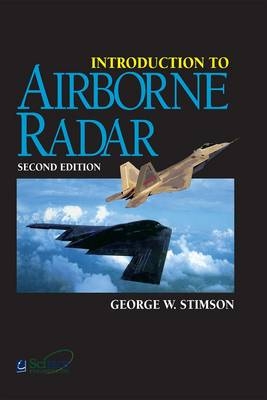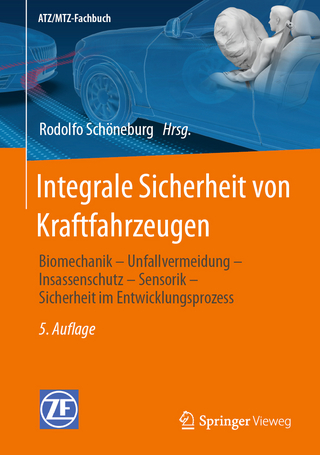
Introduction to Airborne Radar
SciTech Publishing Inc (Verlag)
978-1-891121-01-2 (ISBN)
- Titel erscheint in neuer Auflage
- Artikel merken
Introduction to Airborne Radar is the revision of the classic book privately published by Hughes Aircraft Company in 1983. Lavishly produced in full color, the book was quite unlike any commercially published radar book produced by the major technical publishers. The combination of clear, understandable writing and the unparalleled illustrations established the text-reference as a 'must-have' for engineers, technicians, pilots, and even sales and marketing people within the radar and aerospace industry. The book was authored by veteran Hughes engineer and Technical Manager George W. Stimson, a publications specialist. Individual chapters were thoroughly reviewed by the appropriate experts within the Hughes Radar Systems Group. The book was initially available 1983-1987 only to those within the Hughes family: employees and customers, primarily the military. Restriction was lifted in 1987. Hughes went through three printings and 40,000 copies 1983-1993, mostly by word-of-mouth testimonials and demand. Upon retirement from Hughes, George Stimson successfully negotiated for the rights to the book and made an agreement with SciTech Publishing to do a major revision of the text to update it. The resulting Second Edition has been overwhelmingly positive and a best-seller. Second Edition The revision is extensive: thirteen entirely new chapters cover the technological advances over the fifteen years since publication, two chapters considered obsolete have been deleted entirely, three chapters are extensively rewritten and updated, two chapters have been given new sections, and fourteen chapters have been given minor tweaks, corrections, and polishing. The book has grown from 32 chapters to 44 chapters in 584 efficiently-designed pages. Efforts have been made to bring more even-handed coverage to radars developed outside of Hughes Aircraft, while older and less important Hughes radars have been deleted or abbreviated. Chapter 44 catalogs many of the cutting edge radars in functioning aircraft and near-service aircraft in early stages of production. The book's appeal is to a diverse audience: from military pilots and radar officers eager to gain a sound technical understanding of the complex systems that their lives depend upon, on up through technicians, marketing, and sales people, to the radar system design specialists, who may 'know all that stuff' but who deeply admire the expression and thus use the book to teach others who have questions. The market encompasses companies directly involved in the radar business and those on the periphery, college professors of engineering and physics themselves, along with students in aviation, aeronautics, and electromagnetics and radar courses. The cross-disciplinary and multi-level demand for the book shows that the book should not be pigeon-holed as just a radar book for electrical engineers. Virtually anybody with a knowledge of high school algebra, trigonometry, and physics will be able to read and absorb most of the material.
Part I: Overview of Airborne Radar
Chapter 1: Basic Concepts
Chapter 2: Approaches to Implementation
Chapter 3: Representative Applications
Part II: Essential Groundwork
Chapter 4: Radio Waves and Alternating Current Signals
Chapter 5: Key to a Nonmathematical Understanding of Radar
Chapter 6: The Ubiquitous Decibel
Part III: Radar Fundamentals
Chapter 7: Choice of Radio Frequency
Chapter 8: Directivity and the Antenna Beam
Chapter 9: Pulsed Operation
Chapter 10: Detection Range
Chapter 11: The Range Equation, What It Does and Doesn't Tell Us
Chapter 12: Pulse Delay Ranging
Chapter 13: Pulse Compressions
Chapter 14: FM Ranging
Part IV: Pulse Doppler Radar
Chapter 15: Doppler Effect
Chapter 16: Spectrum of Pulsed Signal
Chapter 17: Mysteries of Pulsed Spectrum Unveiled
Chapter 18: Sensing Doppler Frequencies
Chapter 19: How Digital Filters Work
Chapter 20: The Digital Filter Bank and the FFT
Chapter 21: Measuring Range Rate
Part V: Return from the Ground
Chapter 22: Sources and Spectra of Ground Return
Chapter 23: Effect of Range and Doppler Ambiguities on Ground Clutter
Chapter 24: Separating Ground-Moving Targets from Clutter
Chapter 25: The Crucial Choice of PRF
Part VI: Air-to-Air Operation
Chapter 26: Low PRF Operation
Chapter 27: Medium PRF Operation
Chapter 28: High PRF Operation
Chapter 29: Automatic Tracking
Part VII: High-Resolution Ground Mapping and Imaging
Chapter 30: Meeting High-Resolution Ground Mapping Requirements
Chapter 31: Principles of Synthetic Array (Aperture) Radar
Chapter 32: SAR Design Considerations
Chapter 33: SAR Operating Modes
Part VIII: Radar in Electronic Warfare
Chapter 34: Electronic Countermeasure (ECM) Techniques
Chapter 35: Electronic Counter Countermeasures (ECCM)
Chapter 36: Electronic Warfare Intelligence Functions
Part IX: Advanced Concepts
Chapter 37: Electronically-Steered Array Antennas (ESAs)
Chapter 38: ESA Design
Chapter 39: Antenna RCS Reduction
Chapter 40: Advanced Radar Techniques
Chapter 41: Advanced Waveforms and Mode Control
Chapter 42: Low Probability of Intercept (LPI)
Chapter 43: Advanced Processor Architecture
Part X: Representative Radar Systems
Chapter 44: Reconnaissance & Surveillance
Chapter 45: Fighter & Attack
Chapter 46: Strategic Bombing
Chapter 47: Attack Helicopter
Chapter 48: Transport/Tanker Navigation
Chapter 49: Civil Applications
Appendix
| Erscheint lt. Verlag | 1.12.1998 |
|---|---|
| Reihe/Serie | Radar, Sonar and Navigation |
| Verlagsort | New York |
| Sprache | englisch |
| Maße | 216 x 279 mm |
| Themenwelt | Technik ► Fahrzeugbau / Schiffbau |
| Technik ► Nachrichtentechnik | |
| ISBN-10 | 1-891121-01-4 / 1891121014 |
| ISBN-13 | 978-1-891121-01-2 / 9781891121012 |
| Zustand | Neuware |
| Haben Sie eine Frage zum Produkt? |
aus dem Bereich



